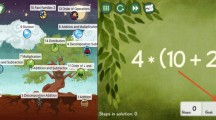Abstract
The concepts of real number sequence, convergence and limit are introduced to all engineering and computer science students in their first semester mathematical analysis course. Teaching methods that have proven to be effective in motivating Generation Z students are a powerful support to keep students’ attention and interest. Building on the advantages of game-based learning, we developed a card game called LimStorm, which was designed to practice the important limits of real number sequences for groups of 4–10 students. In this paper we summarise our empirical experience from the two-year pilot phase.
Access this chapter
Tax calculation will be finalised at checkout
Purchases are for personal use only
Similar content being viewed by others
References
Roh, K.H.: Students’ images and their understanding of definitions of the limit of a sequence. Educ. Stud. Math. 69(3), 217–233 (2008). https://doi.org/10.1007/s10649-008-9128-2
Roh, K.H.: How to help students conceptualize the rigorous definition of the limit of a sequence. Primus 20(6), 473–487 (2010)
Tall, D., Vinner, S.: Concept image and concept definition in mathematics with particular reference to limits and continuity. Educ. Stud. Math. 12, 151–169 (1981). https://doi.org/10.1007/BF00305619
Kidron, I., Zehavi, N.: The role of animation in teaching the limit concept. Int. J. Comput. Algebra Math. Educ. 9, 205–227 (2002)
Flores, A., Park, J.: Students’ guided reinvention of definition of limit of a sequence with interactive technology. Contemp. Issues Technol. Teach. Educ. 16(2), 110–126 (2016)
Cory, B., Garofalo, J.: Using dynamic sketches to enhance preservice secondary mathematics teachers’ understanding of limits of sequences. J. Res. Math. Educ. 42(1), 68–100 (2011)
Watts, E.: University Students Who Play Calculus Video Game Score Higher On Exams, Texas A &M Today, 13 February 2019. today.tamu.edu/2019/02/13/university-students-who-play-calculus-video-game-score-higher-on-exams/
Mohr, K.A.J., Mohr, E.S.: Understanding generation Z students to promote a contemporary learning environment. J. Empowering Teach. Excellence 1(1) (2017). Article 9. https://doi.org/10.15142/T3M05T
Hyrynsalmi, S., Smed, J., Kimppa, K.K.: The dark side of gamification: how we should stop worrying and study also the negative impacts of bringing game design elements to everywhere. In: Proceedings of the 1st International GamiFIN Conference, pp. 96–104 (2017)
Hartman, A., Gommer, L.: To play or not to play: on the motivational effects of games in engineering education. Eur. J. Eng. Educ. 46(3), 1–25 (2021). https://doi.org/10.1080/03043797.2019.1690430
McGonigal, J.: Reality is Broken: Why Games Make Us Better and How They Can Change the World. Penguin Press, New York (2011)
Kordaki, M., Gousiou, A.: Digital card games in education: a ten year systematic review. Comput. Educ. 109, 122–161 (2017). https://doi.org/10.1016/j.compedu.2017.02.011
Szilágyi, S., Körei, A.: “LimStorm’’ – a didactic card game for collaborative math learning for gen Z students. In: Auer, M.E., Rüütmann, T. (eds.) ICL 2020. AISC, vol. 1328, pp. 452–463. Springer, Cham (2021). https://doi.org/10.1007/978-3-030-68198-2_42
Körei, A., Szilágyi, S., Török, Z.: Integrating didactic games in higher education: benefits and challenges. Teach. Math. Comput. Sci. 19(1), 1–15 (2021). https://doi.org/10.5485/TMCS.2021.0517
Szilágyi, S., Körei, A.: Using a math card game in several ways for teaching the concept of limit. In: Auer, M.E., Hortsch, H., Michler, O., Köhler, T. (eds.) ICL 2021. LNNS, vol. 389, pp. 865–887. Springer, Cham (2022). https://doi.org/10.1007/978-3-030-93904-5_85
Author information
Authors and Affiliations
Corresponding author
Editor information
Editors and Affiliations
Rights and permissions
Copyright information
© 2023 The Author(s), under exclusive license to Springer Nature Switzerland AG
About this paper
Cite this paper
Szilágyi, S., Körei, A., Török, Z. (2023). A Game-Based Learning Project - Calculating Limit of Sequences with the Didactic Game LimStorm. In: Auer, M.E., Pachatz, W., Rüütmann, T. (eds) Learning in the Age of Digital and Green Transition. ICL 2022. Lecture Notes in Networks and Systems, vol 633. Springer, Cham. https://doi.org/10.1007/978-3-031-26876-2_87
Download citation
DOI: https://doi.org/10.1007/978-3-031-26876-2_87
Published:
Publisher Name: Springer, Cham
Print ISBN: 978-3-031-26875-5
Online ISBN: 978-3-031-26876-2
eBook Packages: Intelligent Technologies and RoboticsIntelligent Technologies and Robotics (R0)




